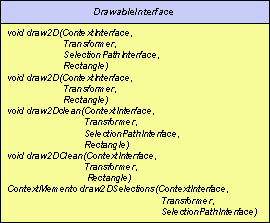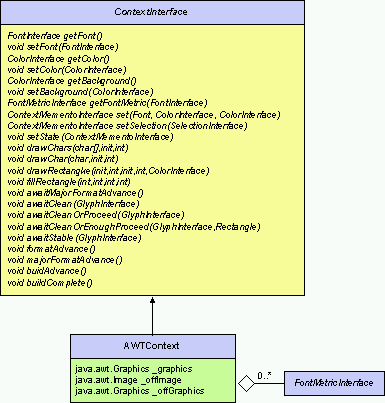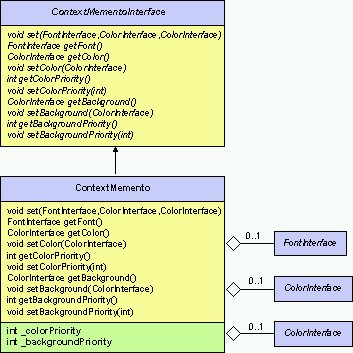|
|
|
|
|
|
|
 Design Design |
 Boxes Boxes |
 Combinator Combinator |
 Formatting Formatting |
 Geometry Geometry |
 Reuse Reuse |
 Selections Selections |
 Paths Paths |
 Concurrency Concurrency |
 Exception Exception |
 Interaction Interaction |
 Utility Utility |
 Resource Resource |
 Drawing Drawing |
 Incremental Incremental |
 Customize Customize |
 Various Various |
Drawing
The API cross references![]() give an immediate access to relevant interfaces and classes.
give an immediate access to relevant interfaces and classes.
 Draw
Draw
A drawable element knows how to draw itself on a
graphical context![]() with or without active
selection.
The box coordinates are relative to the given
transformation
and the drawing area is restricted to a refresh zone.
with or without active
selection.
The box coordinates are relative to the given
transformation
and the drawing area is restricted to a refresh zone.
Efficiency explains the presence of method signature
with or without selection, as in most cases the
selection path will be very light. The "draw clean"
methods address problems relative to
multi-threading.
We do not talk of the only (temporary ?!) cost of
synchonized
code![]() in current java implementation, but also of the cost bind to
design. For example, there is no need to
check every
child before drawing it, if we already know that
the father is clean (i.e. formatted). We could also draw
a cleaned and ordered combinator (like
vertical)
with a dichotomy algorithm relative to the refresh area.
in current java implementation, but also of the cost bind to
design. For example, there is no need to
check every
child before drawing it, if we already know that
the father is clean (i.e. formatted). We could also draw
a cleaned and ordered combinator (like
vertical)
with a dichotomy algorithm relative to the refresh area.

 Graphical Context
Graphical Context
A graphical context is an area on which a
drawable component![]() could draw itself. The current
font,
color and background
are used when drawing and
formatting.
The current resources are masked by active
selections
and decorating boxes.
We use the priority level of the selection to choose
between multiple selections. A selection prevail on a
Decoration. We save and restore the current resources
within a context memento
could draw itself. The current
font,
color and background
are used when drawing and
formatting.
The current resources are masked by active
selections
and decorating boxes.
We use the priority level of the selection to choose
between multiple selections. A selection prevail on a
Decoration. We save and restore the current resources
within a context memento![]() .
The concrete implementation for AWT provides display
operations without flash by the adoption of a classical
double buffer
.
The concrete implementation for AWT provides display
operations without flash by the adoption of a classical
double buffer![]()
Here is the
reason![]() to reify the graphical context.
to reify the graphical context.
Here is the
reason![]() we draw array of bytes instead of simple strings.
we draw array of bytes instead of simple strings.

 Context Memento
Context Memento
A context memento provides a convenient way to save and
restore the state of a
graphical context![]() (i.e. current font, color and background).
(i.e. current font, color and background).

 API Cross References
API Cross References
- Interfaces:
- Classes:
- Exceptions:
 Design Design |
 Boxes Boxes |
 Combinator Combinator |
 Formatting Formatting |
 Geometry Geometry |
 Reuse Reuse |
 Selections Selections |
 Paths Paths |
 Concurrency Concurrency |
 Exception Exception |
 Interaction Interaction |
 Utility Utility |
 Resource Resource |
 Drawing Drawing |
 Incremental Incremental |
 Customize Customize |
 Various Various |
|
Comments or suggestions? Need some help? Copyright ©1998 INRIA Last updated 5 October 1998 by Bruno Conductier |
|